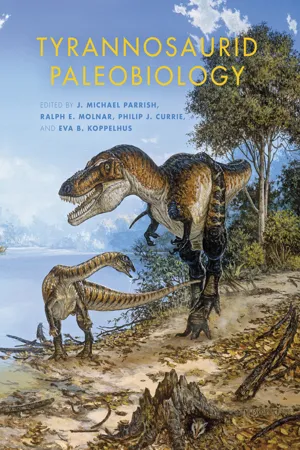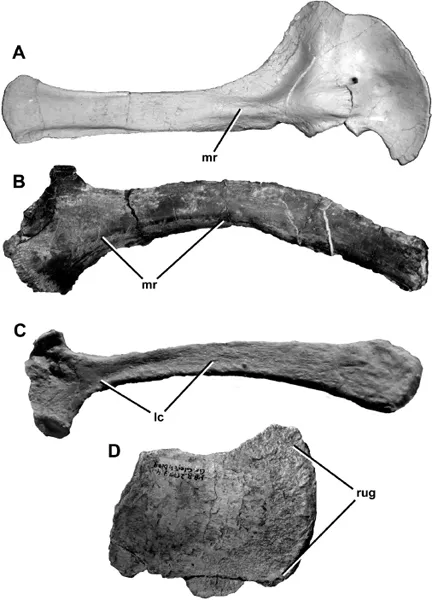![]()
1
Systematics and Descriptions
![]()
1
Phylogenetic Revision of Chingkankousaurus fragilis, a Forgotten Tyrannosauroid from the Late Cretaceous of China
Stephen L. Brusatte, David W. E. Hone, and Xu Xing
1.1. Photographs and line drawings of the holotype of Chingkankousaurus fragilis Young, 1958 (IVPP V 836, right scapula). A) Photograph in lateral view (dorsal to top). B) Photograph in medial view (dorsal to bottom). C) Line drawing in medial view (dorsal to bottom). D) Cross sections from the three indicated areas (lateral to top). Abbreviations: mr, medial ridge; rug, ruosities on posterior expansion of blade. Top scale bar equals 10 cm; bottom scale bar (for cross sections) equals 2 cm.
Introduction
Recent discoveries, especially the feathered theropods of the Jehol Biota, have placed China at the forefront of contemporary dinosaur research (e.g., Chen et al. 1998; Xu et al. 2003; Norell and Xu 2005; Xu and Norell 2006). However, vertebrate paleontology has a long history in China, and the country’s rich dinosaur fossil record has been explored for over a century. Much of the pioneering work on China’s dinosaurs was led by C. C. Young (Yang Zhongjian), the “father of Chinese vertebrate paleontology.” For over 40 years, from the early 1930s until his death in 1979, Young spearheaded expeditions across China and discovered many of the country’s most recognizable dinosaurs, such as the colossal sauropod Mamenchisaurus and the prosauropods Lufengosaurus and Yunnanosaurus (Dong 1992).
In 1958, Young described a single fragmentary bone from the Late Cretaceous (Campanian-?Maastrichtian; see Weishampel et al. 2004; Zhao et al. 2008) Wangshi Series of Shandong Province as a new genus and species of giant theropod, Chingkankousaurus fragilis. This specimen, the posterior region of a large right scapula (IVPP V 836), has long been ignored because of its fragmentary condition. However, those authors who have considered this specimen have often disagreed about its phylogenetic affinities. Young himself (1958) noted similarities with Allosaurus, and much later Dong (1992) formally assigned the specimen to Allosauridae. Steel (1970) and Dong (1979) placed the specimen within Megalosauridae, a wastebasket assemblage of large theropods that are now regarded as basal tetanurans (Benson 2010; Benson et al. 2010). Finally, Molnar et al. (1990:199) referred IVPP V 836 to Tyrannosauridae “on the basis of its very slender scapular blade.” This referral was taken one step further by Holtz (2004), who synonymized Chingkankousaurus with the common Asian Late Cretaceous tyrannosaurid Tarbosaurus. Unfortunately, most of these referrals have been based on vague criteria and were often simply asserted instead of supported by explicit discussion of characters and measurements. This was often unavoidable at the time, but an influx of new theropod discoveries from Asia and elsewhere over the past two decades now allows a firm basis for comparison.
In this chapter, we reassess IVPP V 836 based on firsthand examination of the specimen, compare it with the scapulae of other theropods, and use this information to comment on the taxonomy and phylogenetic placement of Chingkankousaurus fragilis. Although a systematic revision of a fragmentary specimen may seem trivial, it is important to establish the phylogenetic affinities of IVPP V 836 because this specimen has been referred to many disparate theropod groups and comes from an area (Shandong) where the theropod fauna has been more poorly sampled than in many other regions in China. If it truly does represent an allosauroid or megalosaurid, then this specimen would be among the last surviving members of these groups, would greatly expand their stratigraphic ranges in Asia, and would indicate that more basal theropods persisted alongside tyrannosaurids in the large predator niche of Late Cretaceous Asia (contrary to Brusatte et al. 2009b). However, if IVPP V 836 represents a tyrannosaurid or a closely related form, it is further evidence that that these enormous theropods were the sole large predators during the waning years of the Cretaceous in Laurasia.
Institutional Abbreviations AMNH, American Museum of Natural History, New York; HMB, Humboldt Museum für Naturkunde, Berlin; IVPP, Institute of Vertebrate Paleontology and Paleoanthropology, Beijing; JME, Jura Museum, Eichstatt, Germany; LH, Long Hao Institute of Geology and Paleontology, Hohhot, China; MCNA, Museo de Ciencias Naturales y Antropológicas (J. C. Moyano) de Mendoza, Mendoza, Argentina; MPC, Mongolian Paleontological Center, Ulaanbaatar; UMNH, Utah Museum of Natural History, Salt Lake City.
Phylogenetic Definitions and Phylogenetic Framework
In this chapter we use the phylogenetic definitions of Sereno et al. (2005) for Tyrannosauroidea and Tyrannosauridae. Tyrannosauroidea is defined as the most inclusive clade containing Tyrannosaurus rex but not Ornithomimus edmontonicus, Troodon formosus, or Velociraptor mongoliensis. The more derived Tyrannosauridae is defined as the least inclusive clade containing T. rex, Gorgosaurus libratus, and Albertosaurus sarcophagus. In our discussion of tyrannosauroid phylogeny, we follow the phylogenetic analysis and cladogram presented by Brusatte et al. (2010). This cladogram is depicted in Figure 1.5, and major clades are denoted.
Identification
Although fragmentary, IVPP V 836 (Fig. 1.1) can be identified as a partial right scapula owing to its shape and features of its morphology. This bone was originally described as a scapula by Young (1958), an identification that has been followed by subsequent authors (e.g., Molnar et al. 1990). However, Chure (2000) questioned this identification, noting that the symmetrical cross section figured by Young (1958) is unusual for a scapula. Although Young (1958) describes the cross section as symmetrical, in fact the medial surface is convex, and the lateral surface is flat to slightly concave, as is usual for theropod scapulae (Fig. 1.2). This results in a triangular cross section at mid-shaft and a semi-ovoid cross section anteriorly at the broken edge (Fig. 1.1D). The medial convexity is due to a pronounced ridge, described below, which is a normal feature for tyrannosaurid (e.g., Brochu 2003:fig. 80) and other theropod scapulae (Fig. 1.2A–B). Other features of the bone, such as the slightly concave lateral surface and weakly rugose distal end, are also present in theropod scapulae (Fig. 1.2C–D).
Other possible identifications for the bone, including the possibility that it is part of a dorsal rib or a gastral element, are untenable. The specimen is straight along its entire length, whereas theropod dorsal ribs are strongly curved, and only very small fragments would appear straight if observed in isolation (e.g., Madsen 1976:pl. 40; Brochu 2003:fig. 64). Additionally, the dorsal ribs of large theropods often bear a thick ridge on their anterior surface, which is paralleled by a depressed groove (e.g., Daspletosaurus: AMNH 5468). The posterior surface is often corrugated, with a deep groove corresponding to the ridge on the lateral surface. This morphology is not present in IVPP V 836, which has a single ridge on one surface and a flat to slightly concave opposing surface. Although the distal ends of anterior dorsal ribs are sometimes expanded to articulate with the sternum, these expansions are usually slight and rarely, if ever, more than twice mid-shaft depth, as is the case in IVPP V 836 (e.g., Lambe 1917:figs. 6, 7; Brochu 2003:fig. 64).
1.2. Comparative figure showing morphological features common to theropod scapulae, each of which is present on IVPP V 836, supporting its identification as a scapula. A) Aerosteon riocoloradensis (MCNA-PV-3137), left scapula in medial view. B) Falcarius utahensis (UMNH 12279), right scapula in medial view. C) Juravenator starki (JME Sch 200), left scapula in lateral view. D) Liliensternus liliensterni (HMB MB.R.2175), distal end of scapula in lateral or medial view. Abbreviations: lc, lateral concavity; mr, medial ridge; rug, rugosities on posterior expansion of blade.
Similarly, gastral elements of the largest theropods, such as Tyrannosaurus, are smaller than IVPP V 836, and their detailed morphology differs (e.g., Brochu 2003:fig. 70). In particular, although the medial ends of the medial gastral elements may be expanded relative to the mid-shaft, these expansions are usually irregular in shape (not spatulate as in IVPP V 836), extremely rugose, and often fused to the opposing medial gastral element. Additionally, IVPP V 836 is extremely large for a theropod gastral element.
Description
IVPP V 836 is the posterior end of a right scapula, measuring 520 mm long anteroposteriorly as preserved (Fig. 1.1). It is 47 mm deep dorsoventrally at its broken proximal end, and it maintains a relatively constant depth for most of the length of the shaft. However, it thins slightly to 43 mm in depth before expanding distally into a spatulate shape. As preserved, this expansion is 83 mm deep, but both its dorsal and ventral margins are eroded. When the preserved dorsal and ventral margins of the more proximal shaft are extended distally, filling in some of the missing regions, it appears as if the distal expansion was at least 94 mm deep. It is likely, however, that it was even deeper in life, as both the dorsal and ventral edges of the expansion are still quite thick, whereas they usua...


